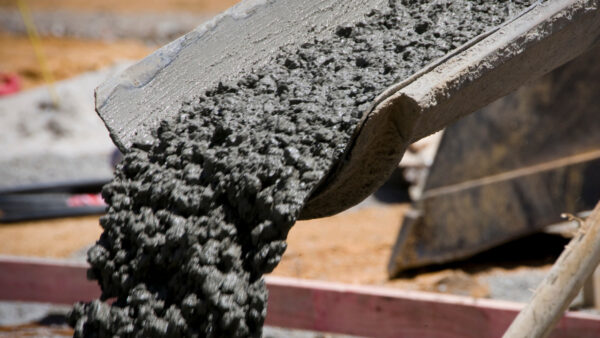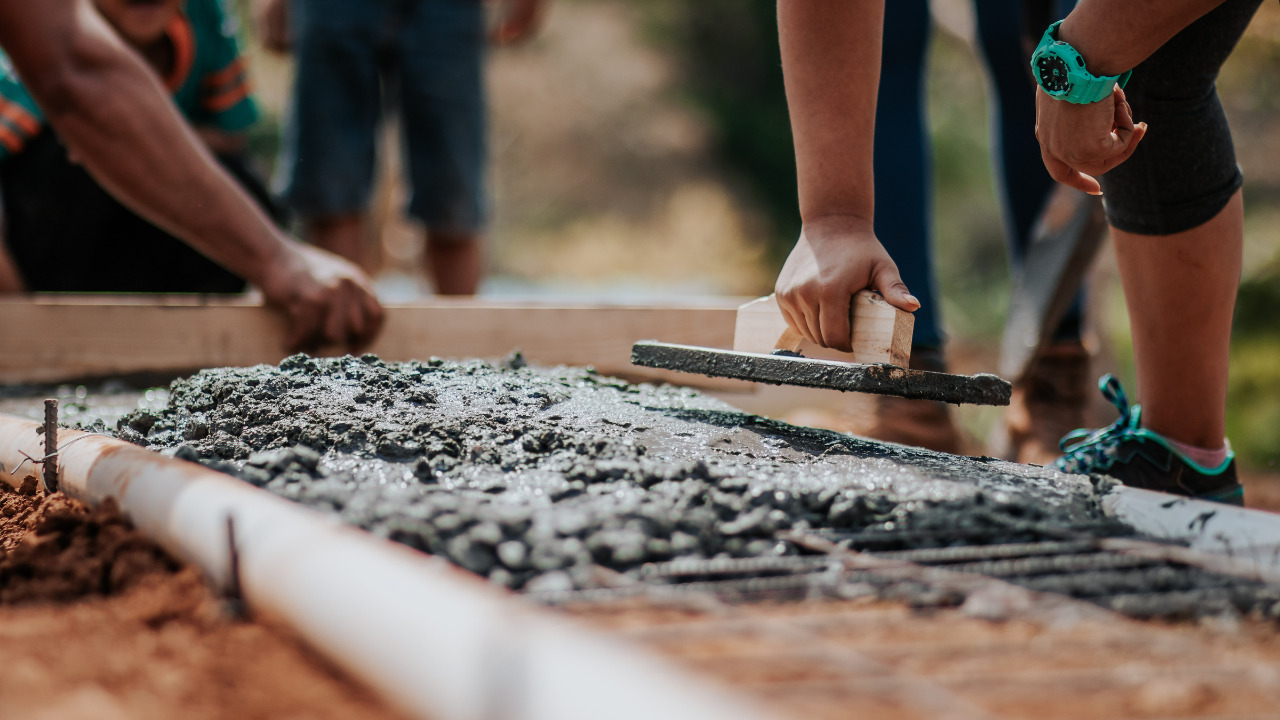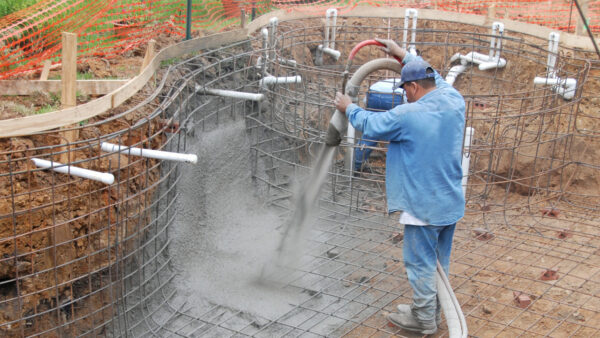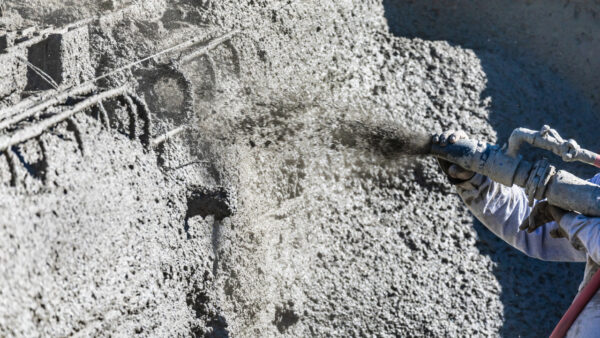If you are embarking on a construction project that involves concreting works, you must be well-informed about the best method of concrete application. You can either go for traditional poured concrete, shotcrete, or gunite.
However, the final choice will depend on a lot of factors that we will discuss as we go along. Before jumping into which application of concrete will be the best for your work, let us discuss in detail all these methods one by one.
Concrete, which is by now, probably known to every Tom, Dick, and Harry who is affiliated with construction works in one way or the other, is a composite building material comprising cement, aggregates and water in calculated proportions to target a particular compressive strength.
Traditional poured concrete in placed into the formwork and in order to compact it, it typically requires a vibrator to remove the air entrapped during the pouring operation. The poured concrete after placing and compacting is finished and cured for the require duration.
Table of Contents
What is Shotcrete?
The term shotcrete derives its origin from the concept of shooting or spraying concrete on a surface instead of pouring it. In early 1900s, this method of applying concrete first began and the results were promising. Ever since then, the use of shotcrete for strength applications became increasingly large.
Shotcrete is a form of concrete application that involves conveying concrete through a hose by pneumatically projecting it at a high velocity on a surface. The concrete that ejects through the hose at a high velocity gets consolidated by the force of this application method.
The ingredients of shotcrete are similar to that of concrete. You will have cement, sand, coarse aggregates and water; however, the coarse aggregates used should be of smaller size and should be harder to account for attrition.
For shotcrete the water-to-cement ratio is generally kept low and admixtures such as set accelerators may be added to accelerate the setting process. No mechanical compaction is required because the high-velocity concrete that impinges on a surface consolidates itself.
Shotcrete proves to be more cost-effective than traditional concrete pouring. This is because it requires less formwork and is already mixed. In addition, it does not require compaction by vibrators.
What is Gunite?
Gunite is a method of concrete application that is similar to shotcrete but involves the use of a high-pressure hose. However, the concrete is loaded dry and mixed with water when it is sprayed.
How to Prepare Shotcrete?
Shotcrete is essentially a form of concrete; however, it is not prepared as traditional concrete mix. You may prepare shotcrete using a dry-mix process or wet-mix process, the former is usually preferred and generally used.
In dry-mix process, dry ingredients such as cement, coarse aggregates, and sand are added in a specialized mixer and then conveyed through a hose into a special nozzle by compressed air. Water is sprayed inside the nozzle under pressure and mixed with the dry ingredients.
The mixture of concrete thus prepared is pneumatically sprayed onto a surface where concrete is to be applied. Pneumatic application involves using a hose and compressed air to ensure the ejected mixture gets well-compacted and bonds with the substrate.
In the wet-mix process of preparing shotcrete, the mix is prepared in the similar way as a traditional concrete mix which is then conveyed or projected to the surface in the similar way as in the dry-mix process.
If you are looking for a step-by-step process for the preparation of shotcrete, here are the guidelines for you so that you don’t mess up at any stage.
- The first step to preparing any concrete mix is the mix design. This means that you need to determine the relative proportions of different ingredients that make up concrete. This design mix will largely depend on the specifications of your construction project.
- The next step is to procure or collect the ingredients proportioned. The required total quantity of a material for your project must be known beforehand.
- Load the dry ingredients into the shotcrete mixer and give them a shake in the dry state.
- Gradually add water into the mixer and keep doing so till the required consistency is achieved.
- Once your shotcrete mix is ready, transfer the wet mix into a shotcrete pump.
- Attach a flexible hose with the pump and project the concrete to where it is to be placed using compressed air. The ejected concrete from the hose will be in the form of a spray that will compact itself once it strikes the surface where it is to be applied.
- Use a trowel to finish and level the surface where the shotcrete is applied.
Unlike traditional pouring of concrete into a formwork, the application of shotcrete should be done with caution. When spraying concrete, you must ensure that protective equipment is worn by the labor and proper ventilation is available in the area.
How to Prepare Gunite?
Gunite is also a method of concrete application that resembles with the shotcrete method. However, it used a gun that utilizes compressed air and water to produce a wet mix that is ejected from the gun.
The step-by-step guide for you to prepare gunite is detailed as follows;
- Just like shotcrete, you need to determine the mix design of concrete based on the specifications of your project.
- Collect the required material quantity.
- Feed the dry ingredients of concrete in a gunite mixer and dry mix them thoroughly.
- Gradually feed water into the mixer and mix up the ingredients well. Doing so, you will have your gunite mixture ready.
- Transfer the mixture into a hopper and connect a flexible hose to this hopper.
- Aim the hose at the surface where it is to be spray-placed.
- Use a gunite gun to spray the mixture onto the surface where placement and finishing operations are to be carried out.
- Use a trowel to smoothen the surface or impart any desired texture to the surface.
- Cure it for a certain period for it to gain strength.
Properties of Shotcrete and Gunite
For strength and durability considerations, shotcrete is a versatile method of applying concrete. Following are some of the key features of shotcrete.
- Owing to reduced w/c ratio and small-sized coarse aggregates, shotcrete has a higher compressive strength. Its strength is tantamount to that of high-quality concrete. Normal shotcrete mixes can conveniently provide a compressive strength of 35 MPa and above.
- Shotcrete is highly durable and resists weathering, abrasion, chemical attack, or any other form of deterioration caused by interacting with the environment. It therefore, performs very well in harsh conditions and ensures longevity of the structural component.
- Time-dependent plastic deformations in concrete such as creep and shrinkage are more in wet shotcrete than that in the dry-mix one.
- The bonding ability of shotcrete is very good. It adheres to the surface where it is applied and creates a strong bond that guarantees structural integrity.
- In shotcrete, normally admixtures are added to accelerate the setting time in order to speed up the construction work.
- For shotcrete, you will only require formwork only one side and this can lead to some saving in the formwork cost. It can even directly bind with the substrate and provide excellent bonding.
- Shotcrete can be molded or formed into any desired shape and this gives flexibility in operation. Different structural shapes can be cast, be it regularly-shaped structures or complex structures.
- In areas which are hard to access and pouring concrete is a challenging task, shotcrete will allow you to convey concrete over a considerable distance in a small diameter pipe.
Just like shotcrete, gunite also has vast applications and is well-suited for different works. Following are some of the key features gunite.
- Just like shotcrete, gunite possesses high compressive strength. You can attain a compressive strength of 35 MPa or more using gunite and this validates its use in structural works.
- It also possesses excellent binding ability just like shotcrete.
- It also provides good durability and resistance to weathering effects.
- More efficient placement of concrete can be carried out using gunite. This is because it used a specialized gun that enables to place concrete in a shorter duration of time.
Applications of Shotcrete
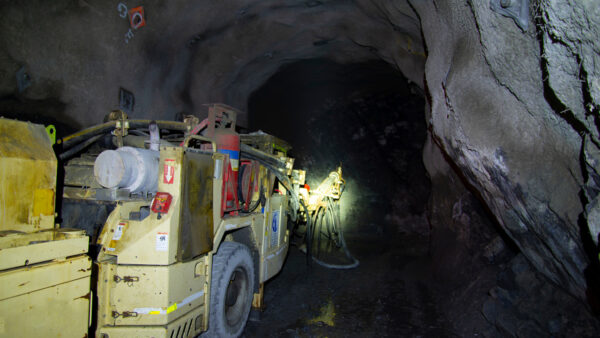
Shotcrete can be used for lining of tunnel walls
Owing to its versatility, shotcrete can be used in a wide range of construction works. Some of its applications are given as follows;
- It is used in tunneling works to stabilize the inside area of a tunnel such as walls, floor, and roof and to reinforce them.
- It can also be used for repairing old concrete members and thin sections. This is because it can bind very well with the substrate and its use in repairing historical buildings is very common.
- It can be used in retaining wall wherein it provides stability to the adjacent soil and prevents soil erosion.
- Shotcrete can also be applied in swimming pools since it is resistant to erosion and weathering action and can be molded into different shapes as per design.
- For the construction of bridge abutments, shotcrete application provides high strength along with durability.
- Shotcrete also serves architectural purposes since it can be used to enhance the look of a structural component such as facades, sculptural elements, decorative walls, etc.
The applications of gunite are more or less the same as that of shotcrete. Gunite can also be used for retaining walls, swimming pools, restoration and repair works of concrete structures, tunnel lining.
In addition, gunite finds its applications in soil stabilization works. The addition of an appropriate binder can help stabilize weak soils and improve their performance. As far as gunite is concerned, it can be used to stabilize plastic soils and increase their stiffness.
Disadvantages of Shotcrete
Although shotcrete is a great way to apply concrete, it has some limitations and cannot be used to replace all types of pouring operations carried out for concrete members.
- Shotcrete cannot be used in confined spaces. This is because the expansion of the compressed air will lead to turbulence and make it difficult for you to carry out the placing and finishing operations.
- The final quality of the product or member is subject to variations.
- Shotcrete is an expensive method of concrete application.
- Highly skilled labor is required to carry out shotcrete application on site.
Which Method to Prefer and Why?
The choice of method for the application of concrete depends on a number of factors which include;
- Budget
- Location where concrete is to be applied
- Skill of the workers applying concrete
If are applying concrete to cast a vertical member, shotcrete is preferred over gunite. In addition, where thicker members are to be cast, the use of shotcrete is a preferred choice. This is because it possesses a higher strength and has less rebound than gunite.
The use of shotcrete is also preferred in certain types of construction works such as construction of retaining walls, tunnel lining using reinforced concrete, etc.
In addition, since shotcrete can be applied using either a dry-mix method or wet-mix method, there is more flexibility in the application process.
However, the final choice to be made depends on other factors, too, which must be considered. The type of project and the concrete member you want to cast will often make it easier for you to come to a conclusion. The preference of a concrete expert must also be considered in this regard.
Cost Comparison
The cost difference in applying concrete by shotcrete or gunite cannot be generalized. This is because for any type of construction project, the costs that will be incurred depends on a number of factors.
In addition, the type of member, its location, and the complexity of pouring operation at site are also governing factors.
However, keeping all other variables constant, shotcrete is more expensive than gunite owing to some additional steps and equipment costs. The added cost becomes justified if you are targeting a higher compressive strength and durability in addition to a lower maintenance and repair cost over time.
If you feel like getting perplexed when making a final decision, consulting a concrete expert for your project is the best way to get to an economical decision.
Frequently Asked Questions (FAQs)
What is meant by the rebound number of concrete?
The rebound number of concrete is a measure of its surface hardness and is determined using a Schmidt hammer or rebound hammer. The hardness of concrete surface is roughly calibrated against its compressive strength.
Rebound hammer test is a type of non-destructive test (NDT) and can roughly predict the strength of concrete as an image of its hardness. In this test, the rebound of a spring-loaded hammer against a surface reflects its hardness.


